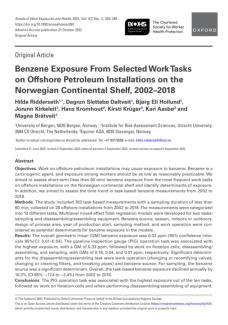Environmental studies 2022











Authors:
Alessandro Lambertini, Massimiliano Menghini, Jacopo
Cimini, Angelo Odetti, Gabriele Bruzzone, Marco
Bibuli, Emanuele Mandanici, Luca Vittuari, Paolo
Castaldi, Massimo Caccia, and Luca De Marchi.
The ability to observe the world has seen significant
developments in the last few decades,
alongside the techniques and methodologies to derive
accurate digital replicas of observed envi-
ronments. Underwater ecosystems present greater
challenges and remain largely unexplored, but
the need for reliable and up-to-date information motivated
the birth of the Interreg Italy–Croatia
SUSHI DROP Project (Sustainable fisheries wIth DROnes
data Processing). The aim of the project
is to map ecosystems for sustainable fishing and to
achieve this goal a prototype of an Unmanned
Underwater Vehicle (UUV), named Blucy, has been
designed and developed.


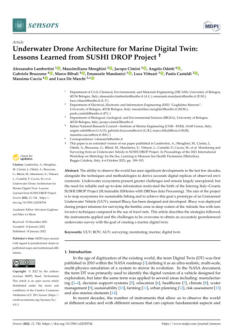

Authors:
Stephanie M. BilodeauI, Austin W. H. Schwartz, Binfeng
Xu, V. Pau´l Pauca, Miles R. Silman.
Abstract:
Understanding long-term trends in marine ecosystems
requires accurate and repeatable counts of fishes and
other aquatic organisms on spatial and temporal scales
that are difficult or impossible to achieve with diver-based
surveys. Long-term, spatially distributed cameras, like those
used in terrestrial camera trapping, have not been
successfully applied in marine systems due to limitations of
the aquatic environment. in this paper, the authors
develop a methodology for a system of low-cost, long-
term camera traps (Dispersed Environment Aquatic
Cameras), deployable over large spatial scales in remote
marine environments.


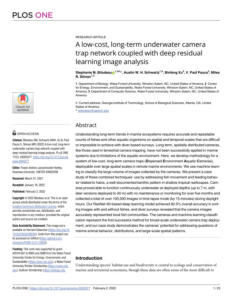

The Energy Transition Index (ETI) has benchmarked
the progress of countries’ energy transition for a
decade on the three dimensions of the energy triangle
– economic development and growth,
energy security and access, and environmental
sustainability – and on the enabling environment for
transition. In view of the current volatile
macroeconomic and geopolitical environment,
however, a trend analysis from historical energy data
can currently provide only limited insights.
Hence, instead of the annual country energy transition
benchmarking report, this special 2022 edition builds
on the ETI trends observed in recent years to provide a
perspective on the current challenges affecting the
transition, and highlights priorities to supercharge it.


.
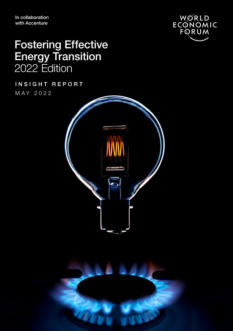

Authors: Lakshman R. T. Pedamallu, Ramiro J. J. Neves,
Nelson E. V. Rodrigues, & J. V. Cruz.
Offshore Geothermal Energy can be considered as a non-
polluting source of renewable energy, in relation to
harmful emissions that are associated with burning fossil
fuels to generate electricity. The geothermal brines of the
mid-ocean ridge hydrothermal vents are believed to be
potential sources of offshore geothermal energy. These
fluids represent one of the most abundant energy
resources worldwide, due to their enormous quantity,
infinite recharge, and high temperatures. However, all
forms of electricity generation impact the environment in
some way. The ecological and biological importance of
the vents restricts the number of areas that can be utilized
to produce electricity.




Authors: Gregory S. Schorr, M. Bradley Hanson, Erin A.
Falcone, Candice K. Emmons, Susan M. Jarvis,
Russel D. Andrews, and Eric M. Keen.
The Pacific Offshore killer whale population is currently
listed as data deficient on the IUCN Red List and
Threatened in Canada. The population is estimated at 300
individuals, extending from Southern California to the
Aleutian Islands in Alaska. To better understand trends,
habitat use, and diving behavior, The authors deployed
seven dart-attached satellite tags during two encounters
with Offshores off California and one meeting off
Washington State in 2013.


.
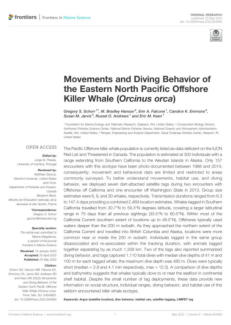

Authors: Rachel D. Moseley, Justyna J. Hampel, Rachel
L. Mugge and Leila J. Hamdan
The studies described in this document aimed to
investigate how historic wooden-hulled shipwrecks
impact the dispersal of wood-colonizing microbial biofilms.
They addressed how proximity to wooden shipwrecks
shapes diversity, richness, and community composition in
the surrounding environment. Study sites included two
historic shipwrecks in the northern Gulf of Mexico
identified as wooden-hulled sailing vessels dating to the
late 19th century.


.
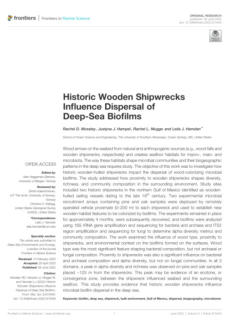

Authors:
Michael G. Bertram, Jake M. Martin, Erin S. McCallum ,
Lesley A. Alton, Jack A. Brand, Bryan W. Brooks, Daniel
Cerveny, Jerker Fick, Alex T. Ford, Gustav Hellström,
Marcus Michelangeli, Shinichi Nakagawa, Giovanni
Polverino, Minna Saaristo, Andrew Sih, Hung Tan, Charles
R. Tyler, Bob B.M. Wong, and Tomas Brodin
The aim of this review is to guide the rapidly developing
field of behavioural ecotoxicology towards increased
environmental realism, ecological complexity, and
mechanistic understanding.


.
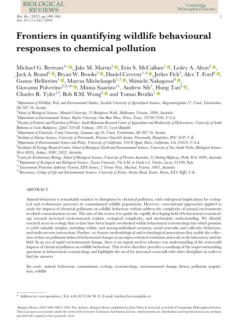

Authors:
Roman Ekhlakov, Ekaterina Romanova, Elena Dogadin,
Sergey Korchagin, Sergey Gataullin, Józef Mosiej,
Timur Gataullin, and Petr Nikitin
A significant group of industrial facilities can be classified
as chemically hazardous facilities (CHFs). To predict the
spread of harmful impurities in the programs being
developed, Gaussian and Lagrangian probabilistic models
are actively used, on the basis of which the complexes
used both in the EMERCOM of Russia and in research
organizations are being implemented.


.
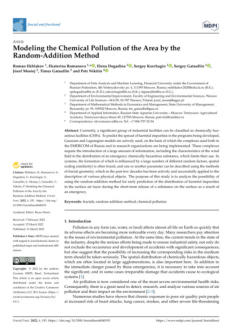

Authors:
Marissa B. Kosnik, Michael Zwicky Hauschild, and Peter
Fantke
This paper proposes an absolute environmental
sustainability framework for chemical pollution where the
chemical pressure on ecosystems is quantified, the ability
of ecosystems to withstand chemical pressure is
determined, and the “ safe space is derived, wherein
chemical pressure is within the carrying capacity and
hence does not lead to irreversible adverse ecological
effects.


.
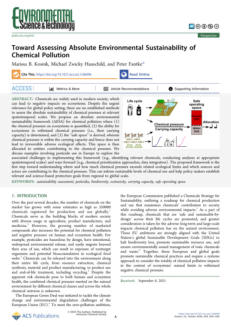

Authors:
Adrian Lee, Benny Jiang, Ingrid Zeng, Michal Aibin
This paper explores the possibility of using computer vision
and underwater Remotely Operated Vehicles (ROVs) to
detect medical waste, such as masks and gloves in oceans.
The authors use a single-stage detector to train the
machine learning approach and then validate the results
using the video feed from the tethered ROV.


.
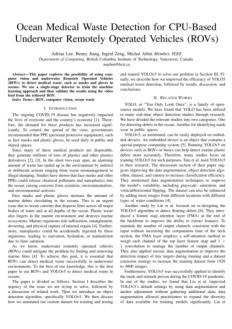

Authors:
Namsrai Jargal, Md Mamun, Chang-Yun Choi, and
Kwang-Guk An
Clarifying how functional traits of aquatic organisms
depend on ecological conditions can facilitate aquatic
conservation and management, but determining the
importance of these traits to ecological river health
requires further investigation. As fish play a vital role in the
assessment of environmental conditions, the authors
examined the relevance of the functional diversity of lotic
fish to the river health assessment using multi-metric
models of water pollution and fish-based biological
integrity.


.
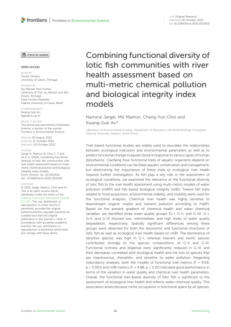

Authors: Ticiana Fettermann, Lorenzo Fiori, Len
Gillman, Karen A. Stockin, and Barbara
Bollard
Generating accurate estimates of group sizes or
behaviours of cetaceans from boat-based surveys can be
challenging because much of their activity occurs below
the water surface and observations are distorted by
horizontal perspectives. Automated observation using
drones is an emerging research tool for animal
behavioural investigations. However, drone-based and
boat-based survey methods have not been quantitatively
compared for small, highly mobile cetaceans, such as
Delphinidae.
The authors conducted paired concurrent boat-based
and drone-based surveys, measuring the number of
individuals in 21 groups of bottlenose dolphin.


.
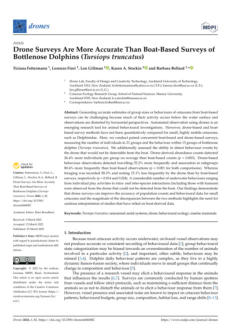

Authors: Aleksandra Koroza, and Peter G. H. Evans
Levels of boat traffic in coastal seas have been steadily
increasing in many parts of the world, introducing
pressures on marine wildlife through disturbance. The
appropriate management of human activities is important
not only to preserve wildlife, but also for the local
communities that depend on ecotourism for employment
and their economy. This study presents further insight into
bottlenose dolphin (Tursiops truncatus) responses to boats
in New Quay Bay (West Wales) within the Cardigan Bay
Special Area of Conservation.


.
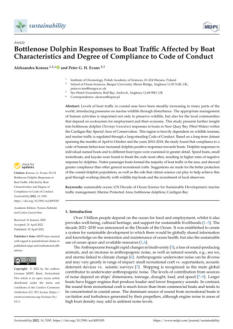

Authors:
Israa Ibrahim Lazim, Samar Jasim Mohammed, Neran
Adran al Naqeeb, and Mohamed I A Fayed.
This study illustrates the importance of some aquatic
plants as bio-indicators of contamination with
hydrocarbons and heavy elements. Aquatic plants have
many applications in treating contamination with
hydrocarbons and heavy components due to their much
lower cost and higher efficiency.
Aquatic plants have been proved in numerous studies to
be sinks for heavy metals and hydrocarbons in aquatic
ecosystems, and it is also used in the treatment process
and to reduce or limit contamination.


.
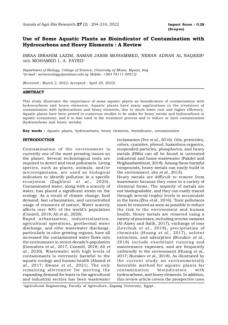

Authors: Mihaela Marilena Stancu
The present study aimed to evaluate the potential of a
Pseudomonas aeruginosa strain to tolerate and degrade
aliphatic petroleum hydrocarbons.


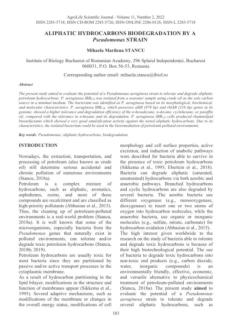

Publisher: US Department of the Interior, Bureau of
Ocean Energy Management, Office of
Renewable Energy Programs
The potential effects of wind energy development on
marine fisheries resources have gained attention due to
the ecological and economic importance of the fisheries
and the repercussions to fishing communities. Fisheries are
exposed to impact from offshore wind energy
development due to port location, the overlap of fishing
grounds and wind energy areas, and the nature of the
gear and vessels used. The impact of excluding fishing
and survey efforts from wind energy areas was examined
using a modeling tool.


.



Authors: Ismail, Grema, M. A. Allamin, Bukar, Adamu,
and Fardami.
Petroleum hydrocarbons are among the major driving
forces of advancement in the last Century. However, some
hydrocarbons are leading to adverse health and
ecosystem stability effects. Environmental pollution with
petroleum and petrochemical products has been
recognized as a significant and severe problem. Most oil
components are toxic to humans and wildlife, as they are
easily incorporated into the food chain. This fact has
increased scientific interest in examining the distribution,
fate, and behaviour of oil and its derivatives in the
environment.


.
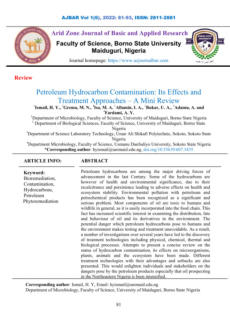

Authors: Central mediterranean Sea - Threatened by
Anthropogenic Impacts (Michela Angiolillo,
Michela Giusti, Lorenzo Rossi, and Leonardo
Tunesi
This study reports the first attempt to quantitatively
describe a Dendrophyllia ramea population on the Apollo
bank (Ionian Sea), revealed in summer 2021 through a
remotely operated vehicle (ROV) survey. The habitat
description, bathymetric distribution, population density,
and structure of the species were assessed by image
analysis.


.
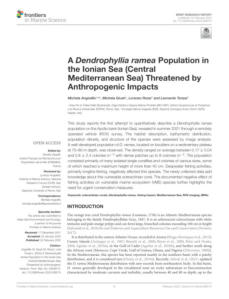

Authors:
M. Riedel, M. Scherwath, M. Römer, C. K. Paull, E. M.
Lundsten, D. Caress, P. G. Brewer, J. W. Pohlman, L. L.
Lapham, N. R. Chapman, M. J. Whiticar, G. D. Spence, R. J.
Enkin, and K. Douglas
Barkley Canyon is off the west coast off Vancouver Island,
British Columbia, Canada. The authors combined repeat
remotely operated vehicle (ROV) sea floor video
observations, mapping with an autonomous underwater
vehicle (AUV), ship-, ROV-, and AUV- based identification
of gas flares, as well as seismic and Chirp data to
investigate the distribution of fluid migration pathways.


.
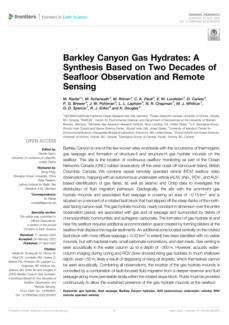

Authors: O. V. Soloveva, E. A. Tikhonova, K. I. Gurov, E.
A. Kotelyanets
The present environmental problems of Balaklava Bay
(Black Sea), which has an increased anthropogenic load
for a long time, are of growing interest.
It is known that high concentrations of hydrocarbons
(HCs) negatively affect the life processes of hydrobionts.
The purpose of this work is to determine the content and
spatial distribution of HCs as well as to assess the possible
sources of their input in the bottom sediments of Balaklava
Bay.


.
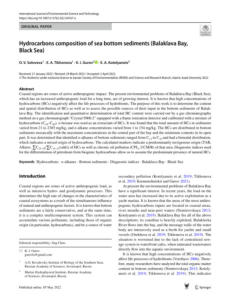

Authors: Rod M. Connolly, Kristin I. Jinks, Cesar Herrera,
and Sebastian Lopez-Marcano
Mobile underwater cameras, diver-operated or on
underwater vehicles, have become popular for
monitoring fisheries. Replacing divers with cameras
has clear advantages, such as creating permanent
records and accessing waters unavailable to divers.
The use of cameras, however, typically produces large
quantities of video that are time-consuming to process
manually. Automated analysis of underwater videos
from stationary cameras using deep learning
techniques has advanced considerably in recent years,
but the use of mobile cameras potentially raises new
challenges for existing methods.


.
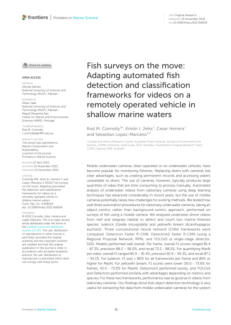

Authors: Maria Bollinger, Keir J. Macartney, Erin E.
Easton, and David W. Hicks
On the continental shelf off the coast of South Texas lie a
series of natural hard-bottom structures (rocky outcrops
and relic coral-algal reefs) known as the South Texas
Banks (STB), which provide critical habitat for benthic
organisms and pelagic fish. The depth of the banks, a
persistent nepheloid layer, and strong currents have
resulted in few studies that provide quantitative
biodiversity data on the STB. Using a remotely operated
vehicle (ROV), video surveys were conducted to
quantitatively describe the mesophotic coral communities
and assess habitat suitability of fiveve STB


.
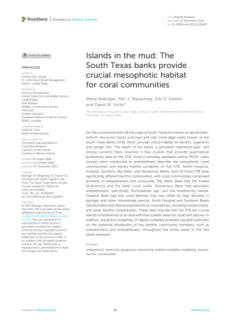

Authors:
Mackenzie E. Gerringer, Yumna Ismail, Kayla A. Cannon,
Arline Camilo Hernandez, Franchesca Gonzales Peralta,
Ryan Bohen, Joseph C. Cartwright, Austin Feasley, Lydia
Fregosi, Hannah Lehman, Hailey Niles, Jillian Quay, Nima
Sherpa, Brett H. Woodworth, and Kasey Cantwell
Access to deep-sea systems has been expanded by
programs such as the National Oceanic and Atmospheric
Administration's Ocean Exploration (NOAA Ocean
Exploration), which uses telepresence to bring deep-sea
exploration to a global audience. The authors of this
paper present an example of how remotely operated
vehicles can engage students in original research.


.
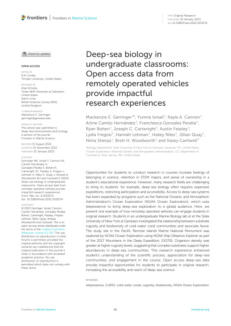

Authors:
Tadamichi Morisaka, Tomo Furuichi, Kazunobu Kogi,
Motoi Yoshioka
The authors propose a group definition for underwater
observations after comparing 234 group transitions from
44 surveys of simultaneous boat-based and underwater
observations targeting the resident Indo-Pacific bottlenose
dolphins around Mikura Island, Japan.


.
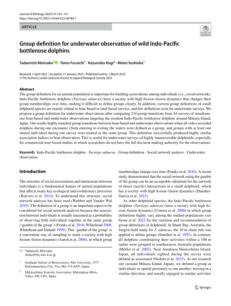

Authors: Carlotta Sacco Perasso, Federica Antonelli,
Barbara Calcinai, Edoardo Casoli, Maria Flavia
Gravina, and Sandra Ricci
Bioerosion is the destruction of hard substrates resulting
from biological activity, and plays a relevant role in the
ecological interactions and coastal dynamics processes.
Several organisms have evolved structures and behaviors
allowing them to perforate biotic and abiotic surfaces,
transforming hard surfaces into particles, and contributing
significantly to sediment production in the coastal and
marine environment. Due to the large geographical
diffusion of marine borers, bioerosion is relevant in many
scientific and applied fields of interest.


.
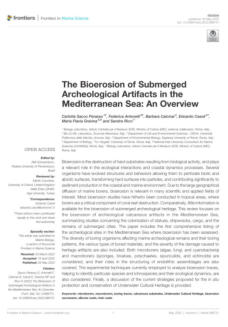

Authors:
Virginia Biede, Andrew R. Gates, Simone Pfeifer, Jane E.
Collins, Carmen Santos, and Daniel O. B. Jones
Large structures are introduced into deep-water marine
environments by several industrial activities, including
hydrocarbon exploitation. Anthropogenic structures can
alter ecosystem structure and functioning in many marine
ecosystems but the responses on continental margins are
poorly known. The authors investigated the short-term
response of benthic megafauna to the installation of a 56
km-long 30 cm diameter pipeline on the Angolan Margin
(Block 31) from 700 to 1800 m water depth using
remotely operated vehicle imager


.
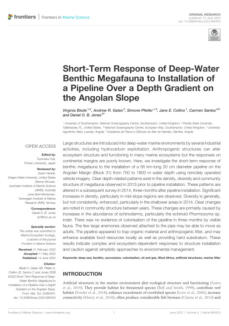

Authors: Hailey L. Davies, Shane Gross, Dana R.
Haggarty, Francis Juanes
Rockfishes are a diverse group of fish in the order
Scorpaeniformes that are distributed globally but
concentrated in the North Pacific. Recognizable by their
large eyes and distinct dorsal spines, the genus is united
by shared characteristics including live births, head spines,
a highly spinous dorsal fin succeeded by a soft- rayed
portion, and musculature attached to a closed
(physoclistous) swim bladder.


.


Authors:
Maciej Liro, Tim H.M. van Emmerik, Anna Zielonka, Luca
Gallitelli, Florin-Constantin Mihai
Mountain rivers are typically seen as relatively pristine
ecosystems, supporting numerous benefits for human
populations living not only in the mountain regions but
also downstream from them. However, recent evidence
suggests that mountain river valleys in populated areas
can be substantially polluted by macroplastics (plastic items
>25 mm). To stimulate future work on this gap, the
authors present a conceptual model of macroplastic
transport pathways through mountain rivers.


.



Click on the
octopus to return to
the top of the page

Publisher: European Climate, Infrastructure and
Environment Executive Agency
This study was commissioned by the European Climate,
Infrastructure, and Environment Executive Agency
(CINEA). It focuses on underwater unexploded munitions
and aims to improve cooperation between Member
States' authorities, private bodies, and regional
organizations in dealing with accidental recovery or
encounters with unexploded ordnances and chemical
munitions dumped at sea, enhance coordination in
monitoring and systematically removing these munitions,
and increase awareness among Member States'
authorities about issues related to underwater
unexploded munitions.


.
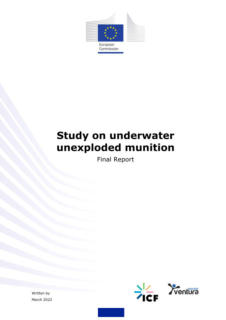

Authors: Kaustubha Raghukumar, Chris Chartrand, Grace
Chang, Lawrence Cheung, & Jesse Roberts
This study quantifies the changes in wind fields at the sea
surface resulting from the deployment of offshore wind
turbines in California's offshore waters. It uses an
atmospheric model to simulate these changes and
assesses the impact on wind speeds and ocean
circulation, particularly focusing on the implications for
upwelling and primary productivity in the region.


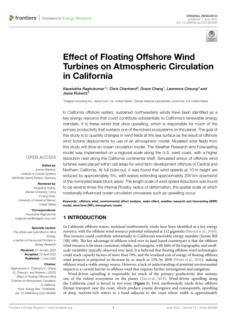

Authors:
Cassandra L. Everett, Oscar Williams, Emma Ruggiero,
Michael Larner, Rachel Schaefer, Matt Malej, Fengyan Shi,
Jules Bruck, & Jack A. Puleo
This study investigated the effectiveness of natural and
nature-based features (NNBF) in protecting shorelines
from ship wake. It focused on a specific installation using
coir logs and wooden staking in a T-head groin
configuration along a low-sloping estuarine shoreline to
evaluate the energy dissipation and velocity attenuation
capabilities of the NNBF installation and to highlight the
potential benefits and limitations of such nature-based
solutions in mitigating the impact of ship wakes on
shorelines.


.
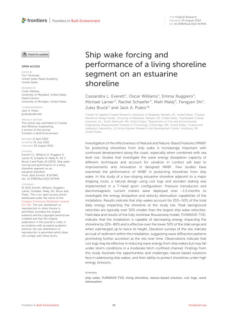

Authors: Oihane Fernandez-Betelu, Isla M. Graham and
Paul M. Thompson
This document discusses the impact of offshore structures
on the behavior of marine predators, specifically harbour
porpoises, to understand how these structures influence
the occurrence and foraging activity of porpoises,
particularly in relation to the time of day. The research
highlights that porpoises are attracted to man-made
structures and that their diel patterns of occurrence and
foraging activity change in the presence of these
structures. The findings are intended to inform
considerations and planning for the decommissioning of
offshore structures.


.

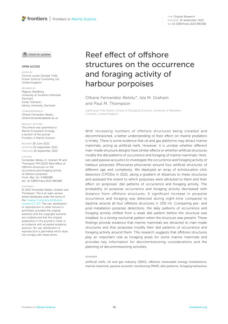

Authors:
Fenghua Zhou, Rongwang Zhang, Shaowei Zhang
This document describes the design, implementation, and
functionality of a low-cost directional inertial wave sensor,
the DWS19-2. It outlines the integration of the sensor with
specific hardware components, its ability to measure
various parameters related to buoy motion, and its
application in calculating wave parameters and spectra. It
also discusses the processing of this data for real-time
transmission and provides details of the electrical design,
on-board processing algorithms, and validation tests.


.
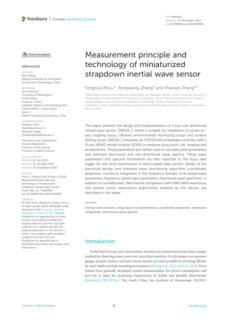

Authors:
Miles J. G. Parsons, Tzu-Hao Lin, T. Aran Mooney, Christine
Erbe, Francis Juanes, Marc Lammers, Songhai Li, Simon
Linke, Audrey Looby, Sophie L. Nedelec, Ilse Van
Opzeeland, Craig Radford, Aaron N. Rice, Laela Sayigh,
Jenni Stanley, Edward Urban, and Lucia Di Iorio
This text advocates for developing a comprehensive, web-
based, open-access platform for passive acoustic
monitoring (PAM) of aquatic environments, highlighting
the importance of such a platform in documenting and
understanding underwater soundscapes, especially in the
context of declining biodiversity and anthropogenic
impacts. It outlines the potential components of the
platform, including a reference library, data repository, AI
training platform, and citizen science application.


.
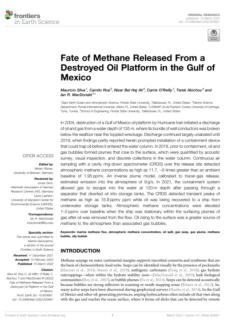

Authors:
Mauricio Silva, Camilo Roa, Nizar Bel Haj Ali, Carrie O’
Reilly, Tarek Abichou, and Ian R. MacDonald
This document is a detailed report on the environmental
impact and response to an oil and gas discharge in the
Gulf of Mexico initiated by the destruction of an oil
platform by Hurricane Ivan in 2004. It describes the
ongoing discharge, the methods used to quantify the
release of oil and gas, and the subsequent containment
efforts. The text also highlights the measurement of
methane emissions into the atmosphere and the
effectiveness of the containment system installed in 2019.


.
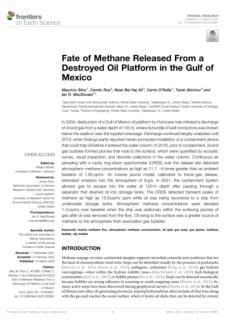

Authors: Mario La Mesa, Simonepietro Canese, Paolo
Montagna, and Stefano Schiaparelli
This study focused on understanding the inshore fish
community of Terra Nova Bay in the Ross Sea, Antarctica,
to provide new insights into the spatial distribution and
habitat relationships of fish species in this area, using an
underwater photographic survey conducted with
remotely operated vehicles, highlighting the identification
of twelve notothenioid species, their depth distribution,
and associations with benthic macrofauna, as well as
documenting nesting behavior in two species. The study
also underscores the ecological importance of inshore
waters for fish activities such as settling, foraging, and
spawning.


.
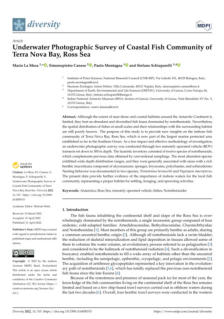

Authors: Edmund Maser, Tobias H. Bünning, Matthias
Brenner, Sven Van Haelst, Maarten De Rijcke,
Patrick Müller, Uwe Wichert, Jennifer S. Strehse
This paper raises awareness about the environmental and
health risks posed by sunken warship wrecks, particularly
those with dangerous cargo such as munitions. It
discusses the potential contamination of the marine
ecosystem and food chain by toxic compounds like TNT,
and presents findings from a specific study (the North Sea
Wrecks project) that investigates these risks. It also
suggests that wrecks should be evaluated not only based
on their impact on sea traffic and infrastructure but also
on their environmental and health threats.


.
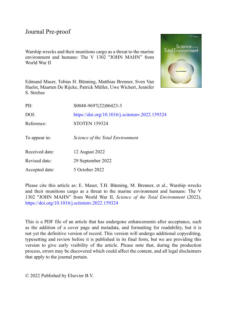

Authors: Ke Zhang, Anson T. H. Ma, Theresa W. L. Lam,
Wei Fang, and Lewis T. O. Cheung
This study explores the preferences of scuba divers in
Hong Kong and how sociodemographic characteristics
and diving experiences influence these preferences to
provide insights for authorities and service providers to
develop effective management plans and offer diverse
recreational opportunities that promote industrial
sustainability and enhance diver satisfaction.


.
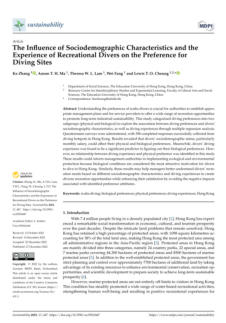

Author: Dong-Gyun Han and Jee Woong Choi
Offshore wind power plants are being built globally,
raising concerns about underwater noise's negative
impact on marine life during construction. A study
measured noise from impact pile driving at a wind farm
in Korea and estimated sound levels. Predictions showed
source levels of 183–184 dB at 1 m, decreasing with
distance. The findings can help assess construction
effects on marine ecosystems when combined with
noise damage thresholds for marine life.


1 - Measurements and Spatial Distribution Simulation of Impact Pile
Driving Underwater Noise Generated During the Construction
of Offshore Wind Power Plant Off the Southwest Coast of Korea.
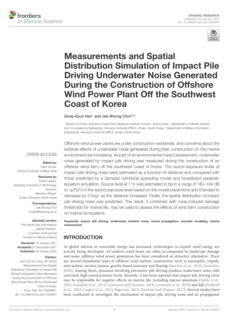



37 - 80 years later: Marine sediments still influenced by an old war
ship
Author: Joseflen Van Landuyt, Kankana Kundu, Sven
Van Haelst, Marijke Neyts, Koen Parmentier,
Maarten De Rijcke, and Nico Boon
Historic shipwrecks are important in marine environments,
but their effects on local chemistry and microbiology are
not well understood. This study examined sediment and
steel samples from the V-1302 John Mahn shipwreck.
Levels of PAHs, explosives, and heavy metals were
measured and linked to microbial makeup, showing that
the wreck still influences nearby sediments and microbial
life even 80 years later.
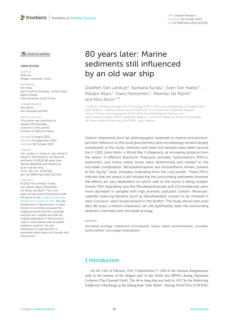



44 - Potential of Small-wind Turbine for Power Generation on
Offshore Oil and Gas Platforms in Malaysia
Authors: Chee Sze Yan, Siow Chun Lim, Chan Kah Yoong
Offshore oil and gas platforms currently use generators,
like gas turbines and diesel power generators. These
generators are not very reliable, especially on unmanned
platforms. Using renewable energy, such as wind
turbines, could enhance energy security, economic
development, and environmental protection. This paper
studies small wind turbines for power generation on
offshore platforms in Malaysia and examines models and
their potential energy production, finding Kerteh,
Terengganu to be the best location for harnessing wind
power.
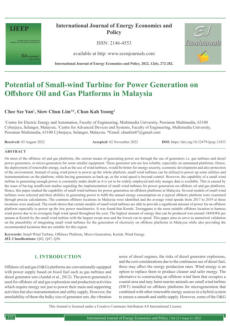


8 - A tradeoff between physical encounters and consumption
determines an optimal droplet size for microbial degradation of
dispersed oil
Authors: Vicente I. Fernandez, Roman Stocker, & Gabriel
Juarez
The study presents a mechanistic encounter-consumption
model to predict the characteristic time for oil degradation
by bacteria in natural marine environments, which
predicts that the tradeoff between encounter time and
consumption time leads to an optimal droplet size larger
than the average size generated by dispersants. Reducing
droplet size below this optimum can increase the
persistence of oil droplets in the environment from weeks
to years. This new perspective changes our
understanding of biodegradation, particularly in deep
ocean environments.
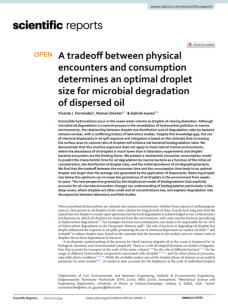



9 - Metagenomic and Metatranscriptomic Responses of Chemical
Dispersant Application during a Marine Dilbit Spill.
Authors: YiqiCao, BaiyuZhang, CharlesW.Greer, Kenneth
Lee, QinhongCai, XingSong, Julien Tremblay,
ZhiwenZhu, GuihuaDong, Bing Chen
The increasing marine transportation of dilbit increases
spill risk, leading to the use of chemical dispersants. The
authors set large-scale microcosms without nutrient
addition to evaluate dispersant effects on dilbit
biodegradation. They found that large-scale microcosms
produced more reproducible community trajectories than
small-scale ones. In the early stage, dispersant addition
enriched Alteromonas, causing depressed degradation of
aromatics. In the late stage, microbial communities
showed high diversity and similar compositions,
suggesting biotransformation of remaining compounds.
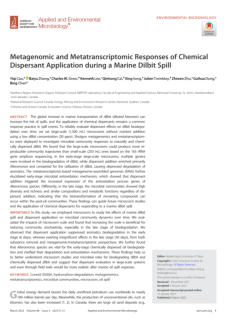


4 - Mesopelagic microbial community dynamics in response to
increasing oil and Corexit 9500 concentrations
Author: Shahd Aljandal, Shawn M. Doyle, Gopal Bera,
Terry L. Wade, Anthony H. Knap, Jason B. Sylvan
Marine microbial communities are vital for breaking down
oil from spills. The effects of chemical dispersants on these
communities after oil spills are unclear. In this study, the
microbial community was exposed to oil and different
concentrations of dispersant. Results showed that lower
oil concentrations led to more similar compositions to
control seawater, while higher concentrations influenced
microbe composition more strongly, highlighting the
importance of both oil and dispersant concentrations in
oil spill research.
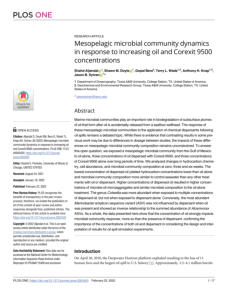



17 - Bacterial Communities and Culturable Petroleum Hydrocarbon
Degrading Bacteria in Marine Sediments in the Northeastern
South China Sea
Authors: Wenhui Xu, Yanlu Qiao, Jinxiao Wei, Qing
Jiang, and Jianliang Xue
Marine oil spill pollution affects the nSCS marine ecology.
This study found that 29 bacterial strains capable of
degrading petroleum hydrocarbons were isolated from
deep-sea sediments. Stenotrophomonas strains
degraded petroleum hydrocarbons efficiently. This
research provides insights into the distribution pattern of
benthic microbial communities and validates the
degradation potential of petroleum hydrocarbons by
indigenous bacteria.
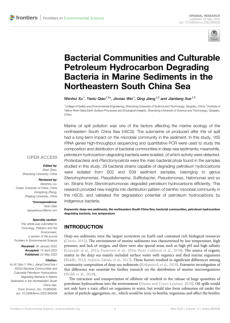


26 - Hydrocarbons removal from synthetic bilge water by
adsorption onto biochars of dead Posidonia oceanica
Authors: Salvatore Cataldo, Nicola Muratore, Francesco
Giannici, David Bongiorno, Vitaliano Chiodo,
Susanna Maisano, Alberto Pettignano
Bilge waters, produced by boats during navigation,
contain hydrocarbons and oils. OWS systems can remove
these pollutants, but they cannot be released into the sea.
Biochars, produced from pyrolysis of dead Posidonia
oceanica, have been tested as hydrocarbon adsorbents.
Adsorption experiments were conducted with aqueous
dispersions, marine gas oil fuel, surfactant, and NaCl
concentrations. The hydrocarbon concentrations were
measured using reverse phase HPLC and GC-MS-MS
techniques.



27 - Marine Debris Floating in Arctic and Temperate Northeast
Atlantic Waters.
Authors: Mine B. Tekman, Lars Gutow, and Melanie
Bergmann
This survey of floating marine debris conducted between
2015 and 2020 in the Northeast Atlantic revealed that
plastic accounted for 91% of all floating items. The median
debris concentration was 11 items km-2, with the highest
in the North Sea. The data showed a slight annual
decrease and seasonal differences in debris
concentrations, with higher levels observed during
summer. Pollution levels were 500 times lower than those
recorded on the seafloor, indicating the seafloor as a sink
for marine debris. Arctic ecosystems face threats from
plastic pollution, which adds to the effects of rapid climate
change.
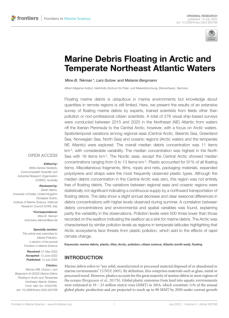



28 - Marine Sponges in a Snowstorm-Extreme Sensitivity of a Sponge
Holobiont to Marine Oil Snow and Chemically Dispersed Oil
Pollution.
Authors: Johanne Vad, Laura Duran Suja, Stephen
Summers, Theodore B. Henry, and J. Murray
Roberts
Holobionts, crucial biological units in marine ecosystems,
are vital for nutrient cycling. Spent sponges, like
Halichondria panicea, host complex microbial
communities and provide essential services. Exposure to
oil, dispersants, and marine oil snow contaminated
seawater revealed a bacterial symbiotic response, partly
due to changes in the host environment. Symbionts
changed their metabolism from aerobic to anaerobic
pathways, possibly via quorum sensing. The study
emphasizes the need for minimizing dispersant use and
considering sponge holobiont vulnerability in
environmental impact assessments.
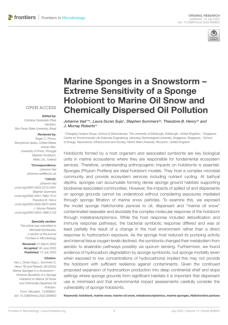



43 - Benzene Exposure From Selected Work Tasks on Offshore
Petroleum Installations on the Norwegian Continental Shelf,
2002–2018
Author: Hilde Ridderseth, Dagrun Slettebø Daltveit, Bjørg
Eli Hollund, Jorunn Kirkeleit, Hans Kromhout,
Kirsti Krüger, Kari Aasbø, and Magne Bråtveit
This study on offshore petroleum installations in Norway
highlighted that workers may be exposed to benzene,
showing that the pipeline inspection gauge (PIG)
operation task was associated with the highest exposure,
followed by work on flotation cells and
disassembling/assembling equipment. It also found that
task-based benzene exposure declined annually by 10.2%
from 2002 to 2018. The exposure was linked to the type
of benzene source used. It concludes that despite the
decline, technical measures should still be considered to
reduce exposure.
